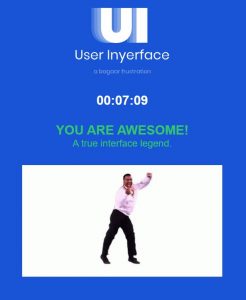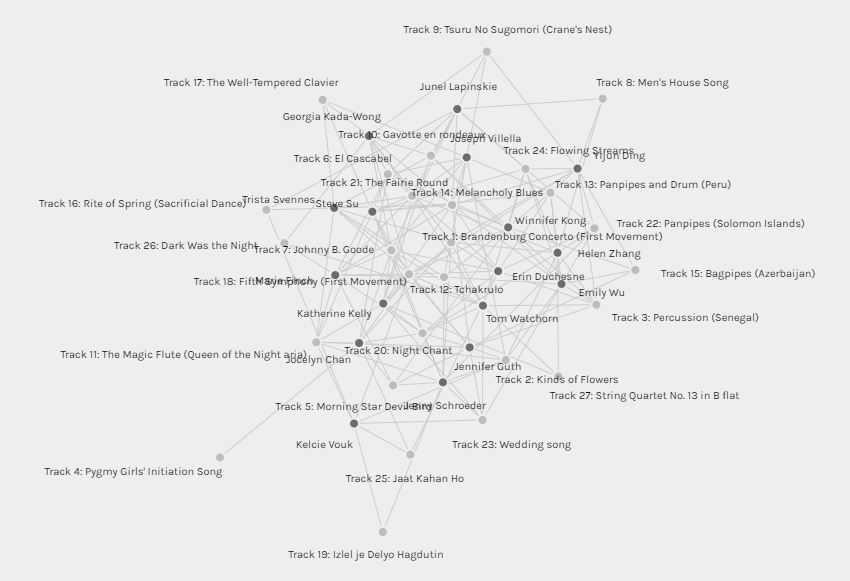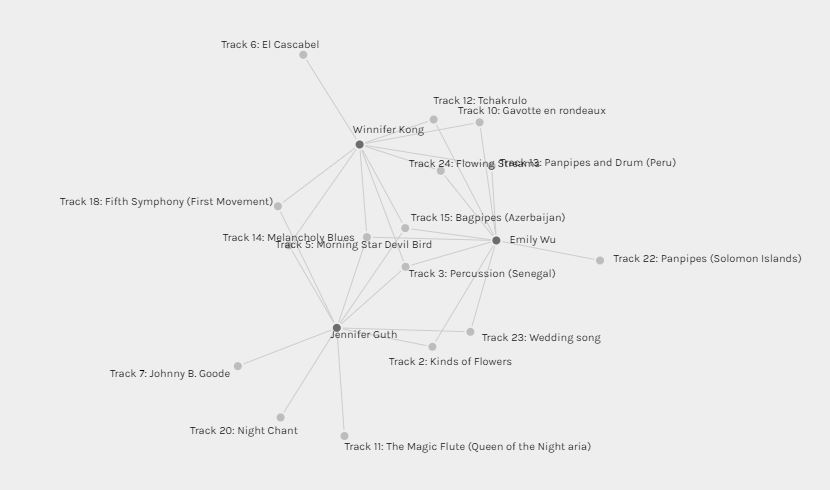The posts to all 6 of my links can be found on this page below. Overall it was super engaging reading through my classmates’ tasks and exploring their take on the tasks. I appreciate how each task gave us freedom to present our post how we like it. For example in the Mode-bending task it was so lovely to see the different forms of media my classmates used to revamp their original “what’s in my bag” task. When approaching this assignment I took the time to look through my classmates’ posts and participated in the activities where possible (e.g., playing a game, figuring out the emoji story, read through a digital book, going back to listen to the songs to see what songs my classmates chose). I took into consideration of the reflection questions situated in our linking assignment criteria and answered them where applicable, but I have also shared my thoughts on the posts; what stood out to me, how they are similar to my posts, and how they differ.
Linking Assignment Site 6
Linking to my classmate’s Marie’s post: Task 12 – Speculative Futures.

For our final task Marie has chosen to create a game to present her task. I love that her take on this task focuses more on the user than the author. In other posts we see our classmates share their ideas on what a utopian and dystopian educational society would look like in 30 years. In Marie’s game, she provides a question with 3 choices to answer from. Depending which question we decide to answer the game will tell us if we chose a utopian or dystopian society. The game allows users to pick the answer they think is the most correct and makes the most sense and the answer will tell us which society we chose (similar to a personality test).
Sharing my experience with the game, after a few questions I started to notice a pattern in which answer would signify a utopian and dystopian society. I found that answers related to technology surrounded a utopian society. Marie’s thoughts to what she portrays a utopian and dystopian society is very similar to how I perceived it. We all know that a utopian society involves a perfect, happy, and problem-less society. In the game, a utopian society would include the most advanced technological device, everyone is happy, and not a single problem would exist.
Our posts differ where my task is embedded into my final project while Marie’s post is on its own. I decided to go in depth of what the educational system would look like 30 years from now in a dystopian and utopian perspective through my final project. I have also explored the task in a first person point of view, reflecting on my ideas and opinions. This is also another aspect where Marie and my post differs, as her site has a privilege that involves user interaction which is her game. What I love about having mini games embedded in websites is that it encourages engagement and motivation for the user.
Task 12 – Speculative Futures
I have collaborated this task with my final project which can be found here!
Final Project: Describing Communication Technologies
For my final project I have decided to create a podcast! This is the only type of multimedia that I have yet to explore in this course whereas in my other tasks I have created videos, presented images, and written paragraphs so I thought it would be cool to try a new way to present my final project. Disclaimer: this podcast does exceed the 10 minute criteria by a bit as I have combined Task 12 with my Final Project. Enjoy!
References:
DiAngelo, R. (2011). White fragility. International Journal of Critical Pedagogy. 3, 54-70.
French, J. (2020). Leaked Alberta school curriculum proposals include cutting references to residential schools, equity. CBC News. Retrieved from https://www.cbc.ca/news/canada/edmonton/education-experts-slam-leaked-alberta-curriculum-proposals-1.5766570
Hodges, C., Moore, S., Lockee, B., Trust, T., & Bond, A. (2020, March 27). The difference between emergency remote teaching and online learning. Educause. Retrieved from https://er.educause.edu/
Linking Assignment Site 5

Linking to my classmate’s Joseph’s post: Task 10 – Attention Economy
I really appreciate the approach Joseph chose for his Task. While a few of our classmates (including myself) expressed our frustration with the User Inyerface game, Joseph took on a more “glass half full” approach and expressed his enjoyment with the game. He points out a really important aspect of human behaviour and how many of us consumers have been conditioned to follow certain patterns on the Internet. This also reminds me of the idea of the concept of usability from ETEC 511 when designing tools, especially learning tools. Woolgar’s (1990) article mentions the dangers “configuring the user” when designing a tool because the system will create a set of actions that predicts what the user will do.
I recall during one of my undergrad courses that my prof mentioned how many of us will overlook the terms and conditions and by default click “okay” without knowing what we have agreed to. When we don’t see these default features on an application, we start to question the accessibility and usability of the interface and this game provides an excellent example of it. Joseph brought up another valid example of the dangers when downloading programs. At times when we want to download a program and the system asks which version or type we want to install, if I’m not familiar with the program (which I am usually not) I will by default click the one that is recommended for us. However, this can be dangerous if we accidentally downloaded a virus or malware into our computer. A few years ago I installed Norton security onto my devices that passively scans for malware and if it detects a shady website or program, it will warn me ahead of time and asks me to confirm if I still want the program/website to be installed. It serves as an additional level of comfort but definitely not something I am immune to and should always be careful with what kind of websites and programs I’m installing.
References:
Woolgar, S. (1990). Configuring the user: The case of usability trials. The Sociological Review, 38, 58-99.
Linking Assignment Site 4
Linking to my classmate Alan’s post: Task 8 – Golden Record Curation.

I appreciate that Alan’s selection of his 10 songs followed a set of criterion; if the song was instrumental, vocal, or culturally diverse. He also included the song purpose; if it describes a human or Earth type of story.
Some of the similarities that both our posts contains is we both first listened to all the songs and and then narrowed down our selections to only 10 songs. Since there were so many beautiful songs to choose from it was difficult to immediately narrow down my song selection to 10. I first listened and chose a set of songs, then went back and re-listened to them and chose the ones that fit best with the theme I had which was songs that expressed exploration and nature vibes. Where Alan and my posts differ is Alan took it another step forward by categorizing the different song types. His post provided a type of culture literacy that allows individuals who visit this site and presented with a type of playlist. Here are a set of songs if you preferred to listen to instrumental. For those who want to listen to cultural or vocal type songs there are separate playlists for that as well. On top of these playlists Alan included a description of each of his 10 songs which is a type of content-authoring that he presents in his post and mine does not. I appreciate that the description allows users to read through the songs and figure out the type of song without having to listen to all of them.
Task 10 – Attention Economy

For this task I attempted to complete it twice. In the first attempt when the pop-up screen came up I didn’t know how to get rid of it. Eventually when during my second attempt I managed to get rid of it by clicking a bunch of things and eventually was able to complete the game.
Reflecting on this game I noticed that the creators attempted to design the features as tedious as possible to demonstrate the importance of having an effective UI design. Every UI has a specific purpose behind their design, but what makes a good and effective design is how the creator builds it. One of the most frustrating part of the game was having to manually remove the placeholder words when asked to fill in our personal information like name, email address, and age. While having these placeholder words are important for the user to know what type of information they need to input, it is more effective if the words automatically disappears when the user clicks on the box. Another frustrating design was the continuous pop-up timer screen. Like I said I attempted the game twice, in my first attempt I didn’t know how to get rid of the pop up timer and assumed I took too long to complete the tasks so I decided to do a second attempt. I received the same pop-up screen despite filling out the sections much faster the second time around so I figured there had to be some way of getting rid of it. Eventually after clicking a bunch of places I got rid of the timer, however it would still pop-up from time to time. I wasn’t sure what the true purpose of the having a pop-up timer was, if anything the UI design made it super ineffective for the user.
I am sure through my personal experiences that I have fallen into many of the dark patterns businesses have used for profit. Brignull’s (2011) article post mentions third party travel websites incorporating many ‘hidden’ fees. Speaking from a recent experience, my friends have almost fell into this type of dark pattern. A few years ago I was told when booking hotels or resorts to never use third party sites such as Booking.com and instead book directly through the hotel or resort website as those companies are more likely to avoid any reservation issues and at times may upgrade rooms if you are lucky. A few weeks ago my friends and I were planning a trip and were looking at resort reservations. I noticed that they were using Booking.com so I suggested using the resort website instead. It turns out that booking on the resort website itself saved us $200. What was interesting about comparing the two sites is that Booking.com originally offered a cheaper price so it seemed like they had a better deal, but they had many hidden fees found at the checkout. Of course as a business the best strategy is to include these extra fees at the checkout because it means that the customer has already made their decision with their booking (or commodity in general) and are more likely to spend the extra dollars to get the product. As consumers we don’t truly realize or pay attention to the marketing techniques businesses use until we actively search for them.
References:
Brignull, H. (2011). Dark Patterns: Deception vs. Honesty in UI Design. Interaction Design, Usability, 338
Task 9 – Network Assignment Using Golden Record Curation Data

This was my first time learning and using the Palladio.app, I found it super cool how the application displays a great visualization of the various song choices my classmates and myself have chosen. What I find especially interesting about music culture is that everyone has a very unique and personal music taste. I would even describe is as intimate because often times I find myself self-conscious when asked about what songs or music genre I like and listen to. Sometimes I’m hesitant to answer immediately in fear of being judged by my music taste because the kinds of music we enjoy can tell a lot about one’s personality.
Looking at the overall map without any filters, I first looked for my name to see where my song choices lie among my classmates. While I was not particularly placed in the middle, I could see that there still many nodes connecting to each other. It was a while since I first listened to these songs so I decided to listen to the songs again, particularly Track 4 as it lied at the very outer edge of the map and Track 12 as it was situated right in the middle of the map. When listening to Track 4 I noticed it was an aggressive and outgoing opera song, whereas Track 12 on the other hand sounded more relaxing and I immediately vibed to it. I could see many individuals listening to Track 12 in various situations; commuting, doing some chores, working, or studying. Because Track 4 has a much stronger vibe, personally I would only listen to it in very specific situations as I would find it more distracting than not especially if I was studying or completing an important task. I would opt to listen to Track 12 instead so I can see why it was a popular choice among myself and my classmates.

Next I decided to filtered my search to look at Community 1 map and observe my song choices with a smaller group of classmates. I noticed here that almost all of the tracks I choose lied within this community. I also observed that Winnifer, Jennifer, and I had many nodes connecting to each other and to these tracks, I interpreted it as of all our classmates, we had the most similar song selections. I compared community 1 to the other 3 communities and noticed that our community was particularly smaller than community 3 and 4 as they had much more nodes and facets. Looking back at my initial goal in Task 8 when choosing these 10 tracks, I specifically chose the ones that were upbeat to give the feeling of exhilaration and excitement when discovering new technologies. I like to think that Winnifer and Jennifer had a similar idea and/or music taste when they chose their 10 tracks.
Task 8 – Golden Record Curation
My 10 song choices of the Golden Record:
Track 2: Azerbaijan S.S.R., bagpipes, recorded by Radio Moscow
Track 3: Bach, The Well-Tempered Clavier, Book 2, Prelude and Fugue in C, No.1. Glenn Gould, piano
Track 10: Stravinsky, Rite of Spring, Sacrificial Dance, Columbia Symphony Orchestra, Igor Stravinsky, conductor
Track 12: “Melancholy Blues,” performed by Louis Armstrong and his Hot Seven
Track 13: “Johnny B. Goode,” written and performed by Chuck Berry.
Track 14: India, raga, “Jaat Kahan Ho,” sung by Surshri Kesar Bai Kerkar
Track 15: Bulgaria, “Izlel je Delyo Hagdutin,” sung by Valya Balkanska.
Track 22: Java, court gamelan, “Kinds of Flowers,” recorded by Robert Brown
Track 23: Senegal, percussion, recorded by Charles Duvelle
Track 24: Beethoven, Fifth Symphony, First Movement, the Philharmonia Orchestra, Otto Klemperer, conductor
The theme that I chose for this assignment was “Exploring and Adventure”. When I think of digitizing I think of humans having the ability to explore and connect with individuals around the world. Through our technological advancement humans can share their ideologies and thoughts to everyone regardless of where they are geographically located. We are able to adventure out to discover new phenomena and purposes. The 10 songs I chose are more upbeat and livelier of the 27 songs, to represent the feeling of exhilaration and eagerness to explore new technology and wonders.
Linking Assignment Site 3
Linking to my classmate Jade’s post: Task 7 – Mode-bending.

Jade’s take on the Mode-bending task was super intuitive for me as I really appreciate her re-design of Task 1. While many of our classmates took on a podcast type of route for this assignment, she created a digital book. The content of the book consists of the items she carries in her bag along with the purpose of why she brings those specific items. Further her book was very interactive as it also included many multimedia features for users to explore with (from a small activity to a video).
Jade used Book Creator to create her assignment while I used Powtoon to create mine. What differs from my assignment is the type of literacies we chose to represent in our re-designed assignment. Jade’s digital book presents reading and writing literacies as it requires her audience to read the content in the book and be able to understand it in order to complete the activity. My video contains media literacy as it presents itself as an “advertisement” and requires my audience to understand the message I attempt to convey. Another tool that I appreciate Jade including in her digital book is the interactive activity which is a great way to facilitate learning. Thinking back to a time during COVID-19 where all learning and teaching was conducted online, many books were unattainable if they were not available online. This digital book is a great alternative for educators who are still working online or within a hybrid environment. It adds a third dimension to books (from text to audio to video) which gives creators endless ideas depending on what Educational field they are surrounded in.
